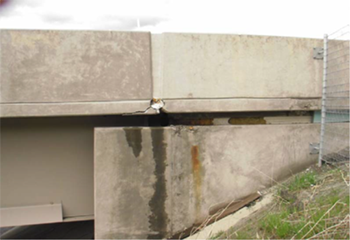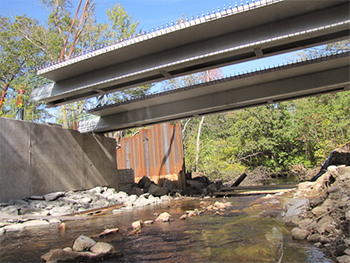InTrans / Oct 01, 2014
The many faces of bridge engineering
Go! Magazine

posted on October 1, 2014
This article is the second in a series: The ABCs of putting “drivers first” in bridge projects.
There are more than 600,000 highway bridges in the United States. Have you ever stopped to think about how much it costs to build just one typical bridge? Even a small bridge that you cross every day, for instance, could cost more than couple of million dollars to build. Further, consider that every one of these 600,000 bridges has to be maintained and repaired when needed, just like a car that we buy and maintain. And more important, the safety of each bridge must be ensured.
The bridge engineering team
For the most part, the responsibility for each bridge lies with the state in which it is located, and the number of bridges in each state varies. For example, there are approximately 15,000 bridges in Nebraska, while there are more than 24,000 bridges in Iowa. In every state there is one government worker responsible for all of the bridges in that state: the state bridge engineer. This is a lot of responsibility for one person, but there are additional people who help the state bridge engineer manage each state bridge. Most of these people have engineering degrees and work for a state government agency called the department of transportation, whose responsibility is to help manage the bridges in each state.
Designing and constructing bridges
To continue the comparison with buying and maintaining a car, consider that when we want to buy a car and when we purchase it, we can go to car dealerships or look at advertisements in different media, such as newspapers. Building a bridge is similar to this process, but much more involved. First somebody has to develop step-by-step procedures for building the bridge, and then the right person to build it has to be determined. There are many different ways of doing this involving engineering, policy, social issues, and economics to name few. However, the most influential person involved in the process of deciding the shape, size, or dimensions of a bridge is an engineer, most often with a degree in civil engineering and, in most cases, someone with at least a master’s degree. In the case of designing long bridges, such as the Golden Gate Bridge, many bridge engineers with different kinds of experience are required.
Inspecting and maintaining bridges
When we buy a car we make sure that we change the oil on time, check the tires to make sure that they are safe and, if needed, replace the tires so that our car can last longer. The car manufacturer usually provides an owner’s manual with information on when to change the oil and when to perform different maintenance tasks. The same is true with bridges. Once a bridge is opened to traffic, it is inspected periodically. In fact, a federal law requires that every roadway bridge be inspected at least once every two years. Based on these inspections, decisions are made to determine what should be done to ensure that the bridge is safe for the public and will last as long as possible. These are called maintenance actions. Spurred by some bad experiences in the past, the tasks of bridge maintenance, inspection, and repair are taken very seriously, and there are federal laws that each state must observe. A few years ago after a bridge in Minnesota collapsed causing many people to lose their lives, the federal government added more laws that each state is required to follow.

New challenges for bridge engineers
Bridge engineering is undergoing many changes. Traditionally, for example, when a new bridge is being built, the construction activities can cause traffic delays and detours for several weeks and even months. The bridge engineering community is developing bridge construction methods that minimize such traveler delays and inconvenience. This is called Accelerated Bridge Construction (ABC), a new field about which engineers are just learning. To share the latest information about ABC, many bridge engineers are planning to get together in Miami, Florida, in December 2014. There is going to be a great need for bridge engineers who can apply ABC technologies and concepts. We invite you to learn more about this specialized and exciting area—or see how you can become a bridge engineer. Contact Brent Phares at Iowa State University, bphares@iastate.edu, 515-294-5879.

Related links
This article is the second in a series about the variety of innovative ABC advancements being implemented across the country: “The ABCs of putting drivers first in bridge projects.” Check out the ABC-UTC homepage: http://www.abc-utc.fiu.edu/
By Atorod Azizinamini, ABC-UTC, Florida International University